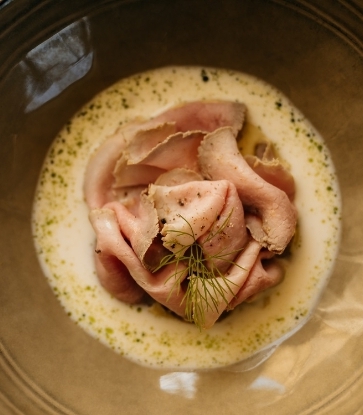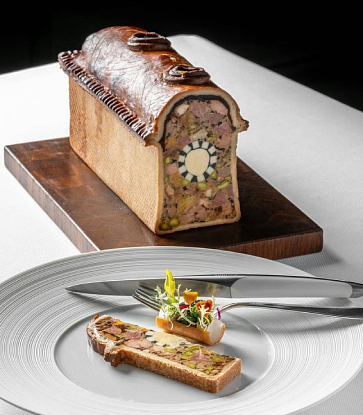São Paulo’s culinary influences are drawn from right across the world, ranging all the way from France to Japan. As well as being a cutting-edge city with the ability to anticipate trends like few others, it is also a metropolis in which the dining scene has absorbed influences transplanted from every continent.
It's impossible to discuss São Paulo’s gastronomic landscape without mentioning the Italian cantinas and restaurants that have led to a unique way of eating out in the city. Yet it's equally important to mention the influence of Japan, whose food culture was disseminated across the largest Japanese colony outside of their homeland, transforming São Paulo into a destination known for its Japanese cuisine. Then, of course, you've got the broad range of influences that have arrived here with people from Spain, Korea, Syria, France, Lebanon, and China, with each one adding something new to the diverse melting pot that is modern-day São Paulo.
In recent years, chefs from around the world (including from neighboring countries) have migrated to São Paulo, bringing with them refined techniques to combine with Brazil's rich pantry of native ingredients. For decades, the best restaurants in the city were concentrated in districts such as Pinheiros, Itaim Bibi, and Jardins. Nowadays, however, this is changing thanks to a trend towards areas adopted by international communities, thus widening the city's gastronomic appeal.
The culinary journey we have outlined doesn't just showcase the city’s gastronomic variety, but invites you to experience a global food odyssey, without the need to look beyond the borders of Brazil's largest city.
Blaise
Rua Itapeva, 435 – Bela VistaLike most of the world's major cities, French cuisine has been a continual part of São Paulo's culinary landscape. However, the classic approach to French food that once revolutionised the way we all eat, has in recent years given way to more informal Francophone projects across the city, yet without losing the original pillars of French technique and refinement. Blaise is a prime example, a MICHELIN Guide restaurant run by Chef Fernando Bouzan inside the Rosewood São Paulo hotel. The focus here is on French cooking that makes good use of Brazilian ingredients (such as Brazil nuts and amburana, as well as cheeses and fish caught along the country’s coastline) to add a tropical touch to the menu, which includes sharing options and even a section dedicated solely to dishes with caviar.
Bicol Korean Cuisine
Rua João Getúlio, 422 – LiberdadeBefore Korean fever conquered global cuisine, Bicol had already established its reputation as one of its most authentic exponents in São Paulo, and in doing so showcased the extensive Korean influence in Liberdade, the district most associated with Asian culture and one traditionally dominated by Japanese restaurants. As well as the classic Korean barbecue cuisine (samgyupsal) which made its name, the restaurant's varied menu ranges from bulgogi to bibimbap. Everything is prepared according to tradition, including the excellent homemade kimchi, which accompanies every dish, and the banchan sides.
Ama.zo – Cozinha Peruana
Rua Guaianases, 1149 – Campos Elíseos / Avenida Higienópolis, 618 – Santa CecíliaConsidered to be one of the world’s most varied cuisines, Peruvian cooking has spread to all corners of the globe. Many restaurants showcasing its virtues have sprung up in São Paulo, but few do so with such personality as this one run by Chef Enrique Paredes. At Ama.zo, which has two branches in the city recommended by The MICHELIN Guide, Enrique's aim is to demonstrate that his native cuisine encompasses much more than just ceviche. He bases his cooking around local ingredients and intense flavors that combine to create dishes evoking the cuisine of Peru's Andes mountains (through different grains and root vegetables) and influences from the Amazonian jungle (hence the name of the restaurant), such as the black tucupi honey that accompanies the grilled scallops or the cupuaçu fruit that appears in other dishes. A native of Lima, the chef scours other regions around his home country, such as Arequipa, to bring an infinite number of different nuances to the table.
Brasserie Victória
Av. Pres. Juscelino Kubitschek, 545 – Itaim BibiSão Paulo has a long history of Syrian-Lebanese cuisine, found in traditional restaurants opened by Middle Eastern people from the 1880s onwards, helping to make dishes such as sfiha and kibbeh as commonplace as sushi and pizza. One of the classic spots for this kind of cooking is Brasserie Victória. Awarded a Bib Gourmand, for over 50 years it has been serving sfihas made with perfectly baked pastry, alongside dishes such as manakish and fried kibbeh. The recipes of founder Victória Feres have not changed over the years and the desserts that she originally created, made with the same pastry, are always crispy and delicate.
Aiô
Rua Áurea, 307 – Vila MarianaTaiwanese cuisine has had a superb ambassador in the city since the MICHELIN-recommended Aiô first opened its doors in the Vila Mariana district. Here, the menu is a tribute “to the roots and memories of Taiwan” across meticulously prepared recipes that hold plenty of flavor, including in dishes as delicate as the tomato salad (with garum and chili oil) and the fish carpaccio (with Taiwanese ponzu). The à la carte, featuring baos and dumplings, is concise yet varied, while the list of cocktails inspired by the flavors of the island provides the perfect complement to the dishes on offer, thanks to the harmony of freshness and spiciness, umami and intensity.
Metzi
Rua João Moura, 861 – PinheirosMexican cuisine offers much, much more than just tacos. In São Paulo, The MICHELIN Guide recommends Metzi if you want a showcase of the country's cuisine through a mix of sophistication and creativity, all thanks to a married couple who worked in renowned restaurants in New York before deciding to open their own eatery in an elegant and airy space in the Pinheiros district. The influences for Luana Sabino and Eduardo Ortiz’s cooking (tostadas, aguachiles, barbecue dishes) can be found in Mexican flavors, which they combine with Brazilian ingredients to create singular recipes teeming with personality. Their salsa macha, a famous Mexican sauce, is made with Brazilian chestnuts and dedo-de-moça chilis, and you’ll even find cumari chili peppers in the house churros (which are an an absolute must).
Fame Osteria
Rua Oscar Freire, 216 – Cerqueira CésarIn the city where the cantina concept was created, it's impossible not to recognize the role played by Italian cucina in the development of São Paulo’s culinary landscape. Chef Marco Renzetti celebrates this tradition at his Fame Osteria. This intimate space, which has been awarded One MICHELIN Star, offers guests grilled dishes and pasta as part of its vision of classic Italian cuisine, alongside a good measure of meticulous care and attention. The tasting menu is likely to include simply yet perfectly grilled vegetables and a comforting lasagne, as well as pastas in a hot broth (brodo) teeming with flavor and exquisite rice dishes varying between risottos and versions with a more Iberian influence, all of which are superbly prepared.
Kuro
Rua Padre João Manuel, 712 – JardinsThere are many outstanding Japanese restaurants in the city, some offering some truly superb sushi, and others exquisitely cooked hot dishes. The One MICHELIN Starred Kuro is a perfect example of these two Japanese cooking styles coming together, in a highly exclusive setting for just 10 guests seated around a counter. Many of its dishes are cooked on a konro, a traditional Japanese barbecue, which delicately grills vegetables, meat, and seafood. The quality of the ingredients is the foundation of its superb omakase menu, which shows great respect for the seasonality of fish and their breeding processes, an ethos that's equally evident in the freshness of the vegetables and the orange yolk of the eggs.
Hero Image: Cavatelli with shellfish and fish roe (© Tadeu Brunelli/Fame Osteria)










